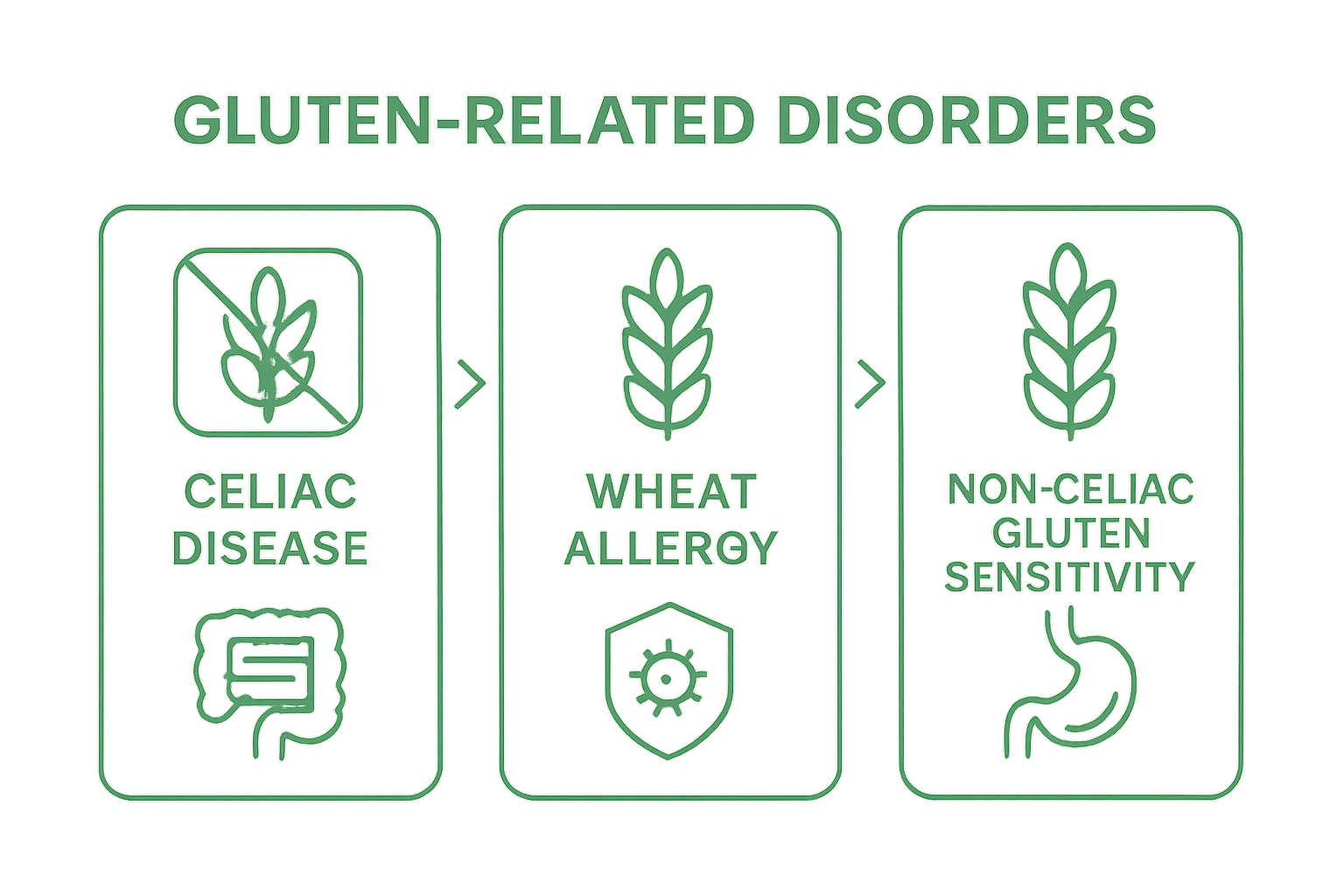Gluten gets blamed for everything from bloating to brain fog but it is quietly responsible for the structure and rise of much-loved breads and pastries. Nearly 1 in 100 people globally have coeliac disease triggered by gluten and millions more report wheat sensitivities. Most people think gluten itself is the villain but its unique protein network is the secret hero behind perfect sourdough, pasta and croissants.
Table of Contents
- Defining Gluten: The Protein Behind Wheat And Grains
- The Importance Of Gluten In Food And Cooking
- Why Do Some People Avoid Gluten? Understanding Sensitivities
- How Gluten Affects Digestive Health And Nutrition
- Exploring Gluten Alternatives And Dietary Considerations
Quick Summary
| Takeaway | Explanation |
|---|---|
| Gluten provides elasticity in bread-making | Gluten’s protein structure allows dough to stretch and hold gas, creating the ideal chewy texture in baked goods. |
| Celiac disease requires strict gluten avoidance | People diagnosed with celiac disease must eliminate gluten to prevent intestinal damage and malnutrition. |
| Gluten influences nutritional absorption | Individuals with gluten sensitivity may face nutritional deficiencies due to impaired absorption in their intestines. |
| Diverse gluten-free alternatives exist | Options like rice, quinoa, and corn provide healthy substitutes for traditional wheat-based products. |
| Professional techniques can enhance gluten quality | Baking professionals manipulate hydration and kneading to achieve various desirable textures in baked foods. |
Defining Gluten: The Protein Behind Wheat and Grains
Gluten is a complex protein composite found naturally in wheat, barley, and rye grains. This unique protein structure gives bread, pasta, and baked goods their characteristic elasticity and texture. Understanding gluten requires exploring its molecular composition and functional properties.
The Molecular Structure of Gluten
At its core, gluten consists of two primary protein groups: gliadin and glutenin.
When wheat flour is mixed with water, these proteins interact and form a sticky, stretchy network that provides structure to dough. According to Harvard T.H. Chan School of Public Health, this protein complex is responsible for the distinctive chewy texture in many wheat-based foods.
Key characteristics of gluten include:
- Elastic and extensible protein network
- Ability to trap gas bubbles during fermentation
- Provides structural stability in baked products
How Gluten Functions in Food Preparation
Gluten plays a critical role in food preparation, particularly in baking. When dough is kneaded, gluten proteins develop and align, creating a lattice-like structure that allows bread to rise and maintain its shape. This protein network enables bread to expand during baking and creates the soft, airy texture many people enjoy.
The molecular research from the National Institutes of Health reveals that gluten’s unique viscoelastic properties make it essential in creating the texture of numerous staple foods worldwide. From pizza crusts to pastries, gluten’s structural capabilities are fundamental to global culinary traditions.
The Importance of Gluten in Food and Cooking
Gluten plays a pivotal role in global cuisine, transforming basic ingredients into complex, textured foods that form the foundation of many culinary traditions. Its unique properties make it an essential component in baking, cooking, and food preparation across cultures.
Culinary Transformations through Gluten
The protein network created by gluten enables remarkable transformations in food preparation. When flour and water combine, gluten develops a stretchy, elastic structure that captures air bubbles during fermentation, creating volume and softness in bread and pastries. According to Johns Hopkins Medicine, this protein network is fundamental to achieving the desired texture in baked goods.
Key culinary functions of gluten include:
- Creating structure in bread and pasta
- Providing elasticity in pizza dough
- Enabling the rise and texture of baked products
Versatility in Global Cuisine
Gluten’s importance extends far beyond basic bread making. In many cuisines, it serves as a critical binding agent that helps create complex textures and flavors. From the delicate lamination of croissants to the robust structure of artisan breads, gluten enables chefs and home cooks to achieve intricate culinary results. Learn more about gluten-free pizza crust alternatives for those seeking alternative dietary options.
Professional bakers and chefs understand that gluten manipulation is an art form. By controlling hydration, kneading techniques, and resting times, they can create everything from tender cakes to chewy bagels. The protein’s ability to develop different textures makes it an indispensable ingredient in professional and home kitchens worldwide.
Why Do Some People Avoid Gluten? Understanding Sensitivities
Gluten sensitivity is a complex health condition affecting millions worldwide, with varying degrees of severity and manifestation. Understanding why individuals choose to eliminate gluten from their diet requires exploring different medical conditions and physiological responses to this protein complex.
Medical Conditions Driving Gluten Avoidance
Three primary conditions prompt individuals to avoid gluten: celiac disease, wheat allergy, and non-celiac gluten sensitivity. According to the National Institute of Diabetes and Digestive and Kidney Diseases, these conditions trigger different immune and digestive responses that can significantly impact an individual’s health and quality of life.
Key health conditions related to gluten sensitivity include:

- Celiac Disease: An autoimmune disorder where gluten consumption damages small intestine
- Wheat Allergy: Immediate allergic response to wheat proteins
- Non-Celiac Gluten Sensitivity: Digestive and neurological symptoms without autoimmune damage
Physiological Responses and Symptoms
Gluten can trigger a range of physiological responses in sensitive individuals. For people with celiac disease, gluten consumption leads to an immune reaction that damages the small intestine’s lining, potentially causing malnutrition and other serious health complications. Check out our insights on gluten-free alternatives to understand how individuals manage their dietary restrictions.
Symptoms of gluten sensitivity can manifest differently across individuals, ranging from mild digestive discomfort to severe neurological and systemic reactions. These may include bloating, abdominal pain, headaches, fatigue, and skin rashes. The complexity of these responses underscores the importance of personalized medical guidance and comprehensive dietary management for those experiencing gluten-related health challenges.
Below is a comparison table outlining the key differences between celiac disease, wheat allergy, and non-coeliac gluten sensitivity as described in the article.
| Condition | Nature of Response | Main Symptoms | Intestinal Damage |
|---|---|---|---|
| Celiac Disease | Autoimmune | Digestive issues, malnutrition, anaemia, fatigue | Yes |
| Wheat Allergy | Allergic (immune hypersensitivity) | Immediate allergic reactions (possible anaphylaxis) | No |
| Non-Coeliac Gluten Sensitivity | Non-autoimmune, non-allergic | Digestive discomfort, headache, fatigue, rashes | No |
How Gluten Affects Digestive Health and Nutrition
Gluten’s interaction with the human digestive system is complex and multifaceted, influencing nutrient absorption, intestinal health, and overall metabolic functioning. Understanding these intricate mechanisms requires a deep dive into how this protein impacts our digestive processes and nutritional well-being.
Intestinal Interaction and Inflammatory Responses
When individuals with gluten sensitivity consume wheat proteins, their digestive system experiences significant challenges. For those with celiac disease, gluten triggers an autoimmune response that damages the small intestine’s delicate villi, which are responsible for nutrient absorption. According to research published in Nutrients, this damage can lead to comprehensive nutritional deficiencies and long-term digestive complications.
Key digestive impacts of gluten include:
- Potential intestinal inflammation
- Disruption of nutrient absorption mechanisms
- Immune system activation in sensitive individuals
Nutritional Absorption and Metabolic Consequences
Gluten sensitivity can create profound nutritional challenges. The intestinal damage caused by gluten can impair the body’s ability to absorb essential nutrients like iron, calcium, and vitamin D. This malabsorption can potentially lead to secondary health conditions such as anaemia, osteoporosis, and compromised immune function.
Individuals managing gluten-related digestive issues must often work closely with healthcare professionals to develop comprehensive nutritional strategies. Learn more about gluten-free dietary alternatives to support optimal digestive health and nutritional balance.
Exploring Gluten Alternatives and Dietary Considerations
Navigating a gluten-free diet requires understanding diverse alternatives that provide nutritional balance and culinary versatility. As more individuals seek gluten-free options, the range of available alternatives continues to expand, offering innovative solutions for dietary management and healthy eating.
Grain and Flour Alternatives
Naturally gluten-free grains provide excellent substitutes for wheat-based products. According to the National Institute of Diabetes and Digestive and Kidney Diseases, several grains offer robust nutritional profiles and can effectively replace gluten-containing ingredients in cooking and baking.
Primary gluten-free grain alternatives include:
Below is a table summarising the most common gluten-free grain alternatives highlighted in the article, along with their characteristics and nutritional benefits.
| Grain | Gluten-Free | Nutritional Profile | Common Uses in Cooking |
|---|---|---|---|
| Rice | Yes | Source of carbohydrates, some B vitamins | Side dishes, baking, pasta |
| Quinoa | Yes | High in protein, contains all essential amino acids | Salads, porridge, baking |
| Corn | Yes | Source of fibre, B vitamins | Tortillas, polenta, cereal |
| Millet | Yes | Nutrient-dense, contains magnesium and iron | Bread, porridge, salads |
- Rice: White, brown, and wild rice varieties
- Quinoa: High-protein pseudocereal with complete amino acid profile
- Corn: Versatile grain used in multiple food preparations
- Millet: Nutrient-dense alternative with mild flavour
Nutritional Considerations and Practical Strategies
Adopting a gluten-free diet requires careful nutritional planning to ensure balanced nutrient intake. Many gluten-free alternatives offer unique nutritional benefits but may lack certain essential nutrients found in wheat products. Explore our guide to understanding gluten-free alternatives to develop a comprehensive dietary approach.
Individuals transitioning to gluten-free diets should focus on diverse food sources, incorporating whole grains, legumes, fruits, vegetables, and lean proteins.
 Consulting nutritionists can help design personalised meal plans that meet individual dietary requirements while maintaining optimal nutritional balance.
Consulting nutritionists can help design personalised meal plans that meet individual dietary requirements while maintaining optimal nutritional balance.
Ready to Make Informed Choices about Gluten? Discover Pure Alternatives Today
Navigating the complexities of gluten and its impact on digestive health can be overwhelming, especially if you are searching for natural ways to manage sensitivities or simply wish to improve your overall wellbeing. If you found the insights about gluten’s effects on nutrient absorption and the potential challenges of a gluten-free lifestyle relevant, you are not alone. Many individuals are looking for genuinely healthy, trustworthy food solutions that do not compromise on taste or nutrition.

Experience peace of mind with our range of organic and gluten-free products specifically selected to support sensitive dietary needs. Visit Nature’s Soul Shop to discover naturally gluten-free staples and pure ingredients across every category. Choose clean eating for yourself and your family and take the next step towards better digestive health and balanced nutrition. Why wait? Explore our full selection now and see how easy it can be to eat well without worry.
Frequently Asked Questions
What is gluten and where is it found?
Gluten is a complex protein found naturally in wheat, barley, and rye. It is responsible for the elasticity and texture of many baked goods such as bread and pasta.
How does gluten affect baking and cooking?
Gluten plays a crucial role in food preparation by providing structure and elasticity to dough. It allows bread to rise and maintain its shape, creating a chewy texture in various baked products.
What are the main health issues associated with gluten?
The primary conditions related to gluten sensitivity include celiac disease, wheat allergy, and non-celiac gluten sensitivity. These conditions can trigger immune responses or digestive issues when gluten is consumed.
What are some gluten-free alternatives to wheat-based products?
Some popular gluten-free alternatives include rice, quinoa, corn, and millet. These grains can effectively replace gluten-containing ingredients in various cooking and baking applications.






